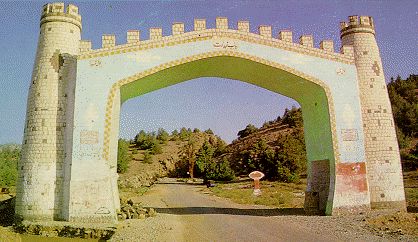

Ziarat

The Home of Second Largest Juniper Tree Forest in the World
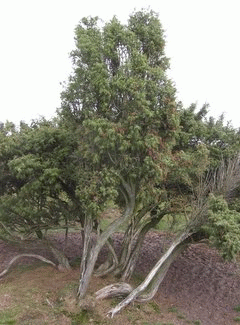 Ziarat - the capital of Ziarat
District of the Balochistan sits at an altitude of 2543 metres (8346 feet). It
is famous for the reason that Mr.Jinnah, the founder of Pakistan stayed here
during the last few days of his life in September 1948. The site was chosen for
the ailing great man because Ziarat offers the best of the climates, specially
in the summers. Besides, Mr. Jinnah had great personal liking for Ziarat. It is
because of this reason that the small double storey Ziarat Residency has won the
position of a national monument. The hills around Ziarat are thickly wooded and
are home to the world's second largest Juniper trees. The junipers are
considered to be the real treasure of Ziarat. There are trees in the valley
which are more than 7000 years old. In Ziarat a herb called Ephedra sinica is
found in abundance from which a chemical called ephedrine is extracted, an
important constituent of various medicines, especially cough syrups. When the
snow falls in Ziarat's winter the juniper valley is at its most beautiful. The
local dish of Ziarat is "saji". More tourists visit the place in summer.
Read More about Juniper Forests.
Ziarat - the capital of Ziarat
District of the Balochistan sits at an altitude of 2543 metres (8346 feet). It
is famous for the reason that Mr.Jinnah, the founder of Pakistan stayed here
during the last few days of his life in September 1948. The site was chosen for
the ailing great man because Ziarat offers the best of the climates, specially
in the summers. Besides, Mr. Jinnah had great personal liking for Ziarat. It is
because of this reason that the small double storey Ziarat Residency has won the
position of a national monument. The hills around Ziarat are thickly wooded and
are home to the world's second largest Juniper trees. The junipers are
considered to be the real treasure of Ziarat. There are trees in the valley
which are more than 7000 years old. In Ziarat a herb called Ephedra sinica is
found in abundance from which a chemical called ephedrine is extracted, an
important constituent of various medicines, especially cough syrups. When the
snow falls in Ziarat's winter the juniper valley is at its most beautiful. The
local dish of Ziarat is "saji". More tourists visit the place in summer.
Read More about Juniper Forests.
Ziarat literally means a place for pilgrimage. Ziarat as a small dwelling existed much before the advent of thc British Rule in the Sub-continent. Its local name then was Gwuskhi or Kowashki and was changed to its present name of Ziarat in 1886. It derived its name from the neighbouring shrine of famous Muslim saint Mian Abdul Hakim, popularly known as Mulla Tahir and Kharwari Baba. The shrine is situated in the valley, below the "Prospect Point (see photo below)", south of Ziarat Town. According to a legend, the Saint came here from Khandahar in Afghanistan, He opposed the highhandedness of Ghlzai King Hussain. He was forced to leave his native town and migrated to this place. On reaching this valley he took abode on a hill top and prayed for this place saying: "This place shall flourish". Thereafter water started oozing from the spot which is still flowing and is regarded as holy and wholesome.
View of Ziarat from Prospect Point - Photo Courtesy Autumn Sun and Autumn Colours
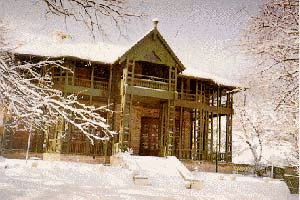 Ziarat
was first selected as health resort by the British in 1883. Till then it was a
remote area with few mud houses. The history of Ziarat during the British
colonial administration is the same as that of the Sibi district of which it
was a part until 1986. The area came under British colonial influence by the
middle of the last century, and was made a part of British India in 1887
like the rest of the old Sibi district. Two years earlier, in 1885, the
British Government had acquired land for construction of a civil station (at
the present Ziarat town), on payment of Rs.1,400,000 to the Saidzai sub
section of the Sarangzai tribe. Before the creation of Sibi district (in
1903), Ziarat used to be the summer headquarters of Thal and Chutiali
District (Duki Sajavi Sub Division). Later when the Sibi District was
created in 1903, it became Sibi District’s summer headquarters. It formed a
part of Shahrigh Tehsil of Sibi District till 1974 when it was given the
status of a sub-tehsil. The first building to come up there was the
Political Agent's residence which was constructed in 1891 at a total cost of Rs.
19,666. Piped water was provided to the town in 1898-99 at a cost of Rs, 38,000.
A summer camp for European troops stationed at Quetta was first set up at Ziarat
in 1885. At that time income of this tiny town stood at Rs. 38010 and
expenditure at Rs. 2,689. Before Independence, the camp offices of the Agent to the Governor General
in Balochistan; the Revenue Commissioner, Balochistan; the Civil Surgeon,
Balochistan; the Political Agent and the Colonization officer, Nasirabad,
used to shift to Ziarat during the summer. Following the creation of Sibi
Division in 1974, the divisional offices shifted to Ziarat during the summer.
Ziarat
was first selected as health resort by the British in 1883. Till then it was a
remote area with few mud houses. The history of Ziarat during the British
colonial administration is the same as that of the Sibi district of which it
was a part until 1986. The area came under British colonial influence by the
middle of the last century, and was made a part of British India in 1887
like the rest of the old Sibi district. Two years earlier, in 1885, the
British Government had acquired land for construction of a civil station (at
the present Ziarat town), on payment of Rs.1,400,000 to the Saidzai sub
section of the Sarangzai tribe. Before the creation of Sibi district (in
1903), Ziarat used to be the summer headquarters of Thal and Chutiali
District (Duki Sajavi Sub Division). Later when the Sibi District was
created in 1903, it became Sibi District’s summer headquarters. It formed a
part of Shahrigh Tehsil of Sibi District till 1974 when it was given the
status of a sub-tehsil. The first building to come up there was the
Political Agent's residence which was constructed in 1891 at a total cost of Rs.
19,666. Piped water was provided to the town in 1898-99 at a cost of Rs, 38,000.
A summer camp for European troops stationed at Quetta was first set up at Ziarat
in 1885. At that time income of this tiny town stood at Rs. 38010 and
expenditure at Rs. 2,689. Before Independence, the camp offices of the Agent to the Governor General
in Balochistan; the Revenue Commissioner, Balochistan; the Civil Surgeon,
Balochistan; the Political Agent and the Colonization officer, Nasirabad,
used to shift to Ziarat during the summer. Following the creation of Sibi
Division in 1974, the divisional offices shifted to Ziarat during the summer.
The tribes of the area are Sarabgzais, Tarins, Syeds, Doomars and lsakhels - all Pashtoons. The people are generally sturdy and very hospitable. A trip to Ziarat from Quetta can be made by two routes one by the single road, which though a short-cut, is very difficult but full of fun and excitement for the hunters. The other is the Quetta- Karachi-Ziarat Road. It is a metalled road with road side tea shops. After traveling over 43 miles of the ragged country side one reaches Kachh where, besides a few tea shops, there is a Rest House equipped with necessary facilities. Thereafter a 33-mile long hilly track takes one to the green valley of Ziarat. This part of the journey is quite interesting and one comes across lofty hills covered with a thick juniper, patches of green fields and clean and cold water springs. There are many lovely walks through the wooden glades. Huge gorges and defiles constitute a feature of the scenery. For spending a holiday delightfully cool Ziarat is very pleasant and enjoyable,
Beside Juniper, which is the major species of trees, other major species include Wild Ash; Wild Almond; Olea species; Khujak. The magic of Ziarat lies in its honey-flowers which attain a large size here, its lush green grass and cool weather even in the hottest months of summer. 'Shinshoab' a lavender-like wild bush, looks lovely in twilights. Ziarat is also famous for its sweet apples, black and red cherry. The cherry season lasts from the 1st to 15th of June.

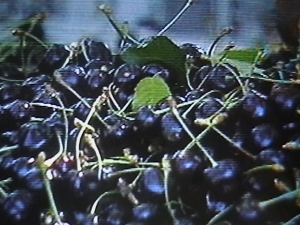

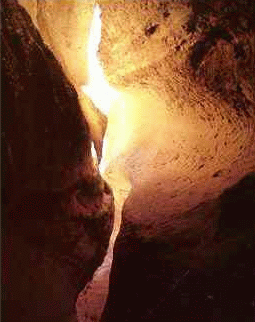 Within
easy reach of the town, the Ziart (or sometimes Sandeman) Tangi (leftt) is a narrow
gorge between lofty mountains culminates in a perennial spring. There are
more than half a dozen gorges around Ziarat formed by natural 'Karez' -
spring water falling through narrow openings amongst the mountain rocks
producing a dramatic effect. The sound of waterfalls singing to the tune of
solid rocks while passing through narrow gorges creates a mystic atmosphere.
The famous gorges along the road to Ziarat are Chutair Tangi, Kahn Tangi,
Kawas Tangi, Fern Tangi and Sandeman Tangi. One can approach easily to these
gorges by diverting from the main road to have a picnic, adventure and fun.
A walk to Chashma is favourite
amongst joggers and those who wish to have a pleasant walk. Situated 6 km
from Ziarat the 'Prospect Point' offers breathtaking view of the valley. It
was because of its scenic beauty that a Hollywood film company included a
few shots of the Sandeman Tangi in its film "Jengis Khan" in 1952.
Within
easy reach of the town, the Ziart (or sometimes Sandeman) Tangi (leftt) is a narrow
gorge between lofty mountains culminates in a perennial spring. There are
more than half a dozen gorges around Ziarat formed by natural 'Karez' -
spring water falling through narrow openings amongst the mountain rocks
producing a dramatic effect. The sound of waterfalls singing to the tune of
solid rocks while passing through narrow gorges creates a mystic atmosphere.
The famous gorges along the road to Ziarat are Chutair Tangi, Kahn Tangi,
Kawas Tangi, Fern Tangi and Sandeman Tangi. One can approach easily to these
gorges by diverting from the main road to have a picnic, adventure and fun.
A walk to Chashma is favourite
amongst joggers and those who wish to have a pleasant walk. Situated 6 km
from Ziarat the 'Prospect Point' offers breathtaking view of the valley. It
was because of its scenic beauty that a Hollywood film company included a
few shots of the Sandeman Tangi in its film "Jengis Khan" in 1952.
Prospect Point is an excellent picnic spot 372 miles south of the town. There is a jeep able road but those who want to enjoy the scenic beauty at leisure can have a walk. The road which passes through the lofty hills and deep ravines overlooks the valley, about 1000 feet below, covered by the ever-green juniper trees. There is a newly constructed Rest House from where one could have a wonderful view of the valley particularly during the rainy season. Down below is the shrine of Kharwari Baba.
Related Links: | Ziarat | Ziarat ( Wikipedia ) |
|
| HOME PAGE | MORE CITIES |
This page was created on 20 December 2008 |